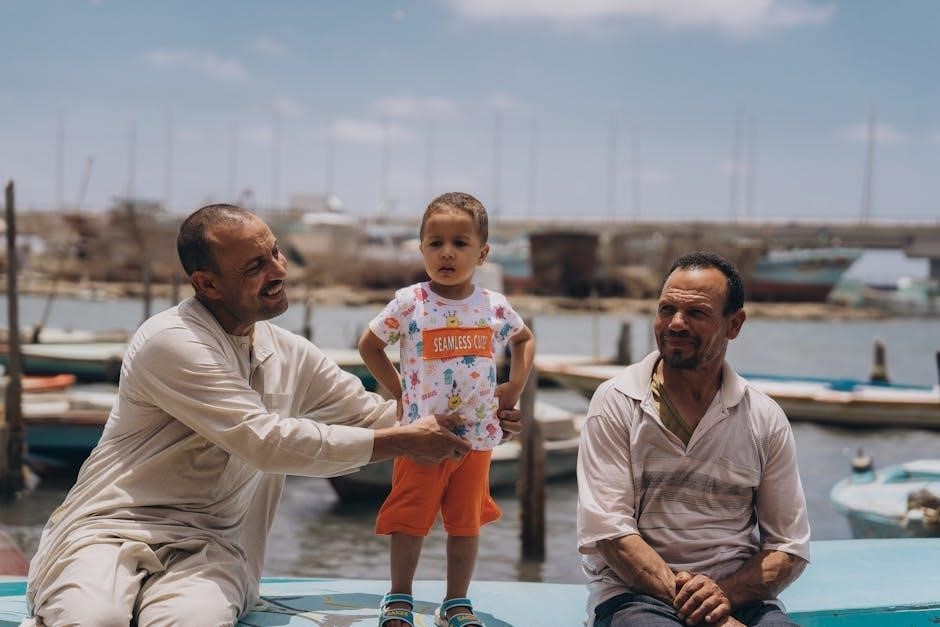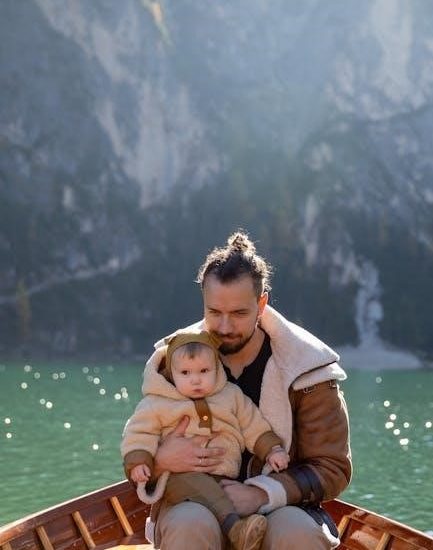Welcome to the parent guide for The Boys in the Boat, a historical sports drama based on a true story. Rated PG-13 for language and smoking, this guide helps you evaluate its suitability for your child, covering themes, content, and recommendations for different age groups.
Overview of the Movie and Its Significance
The Boys in the Boat is a historical sports drama directed by George Clooney, based on Daniel James Brown’s bestselling book. It tells the inspiring true story of the University of Washington’s rowing team as they overcome socioeconomic challenges and compete in the 1936 Berlin Olympics. The film highlights themes of perseverance, teamwork, and resilience, making it a powerful underdog story. With its uplifting message and historical significance, it appeals to sports enthusiasts and history buffs alike, offering a cinematic experience that celebrates determination and the human spirit.
Why This Guide is Essential for Parents
This guide is crucial for parents to evaluate if The Boys in the Boat aligns with their child’s sensitivity levels. It provides detailed insights into the film’s content, including language, smoking scenes, and mature themes. By understanding the PG-13 rating and specific content, parents can make informed decisions about whether the film is suitable for their children. Additionally, the guide highlights the movie’s positive messages, helping parents discuss its themes and values with their kids, ensuring a meaningful and age-appropriate viewing experience.

MPAA Rating and Content Overview
Rated PG-13 for language and smoking, this film offers a heartwarming true story with themes of perseverance and teamwork, suitable for mature audiences.
Why “The Boys in the Boat” is Rated PG-13
The film is rated PG-13 for language and smoking, reflecting its historical 1930s setting. While the story is uplifting, these elements make it suitable for mature audiences with parental guidance.
Language and Smoking in the Film
The film contains mild profanity and smoking, reflecting its 1930s setting. While the language is not excessive, it includes occasional strong words. Smoking is depicted as common for the era, though it may concern some parents; These elements are key considerations for deciding if the movie is appropriate for your child.
Sexual Content and Nudity
The Boys in the Boat contains no explicit sexual content or nudity. Romantic moments are mild, with subtle kissing and flirting scenes that are appropriate for most audiences. The film focuses more on teamwork and perseverance than intimate relationships. While the PG-13 rating includes language and smoking, there are no concerns regarding sexual content. Parents can feel assured that the movie maintains a wholesome tone, making it suitable for older children and teenagers.
Violence and Gore
The Boys in the Boat does not contain any explicit violence or gore. The film focuses on the emotional and physical challenges faced by the rowing team, but these are portrayed in a manner appropriate for most audiences. While there are intense racing sequences, they are more thrilling than violent. Parents can expect a clean and inspiring story with no graphic or disturbing content. This makes the movie suitable for younger viewers, though discretion is advised for sensitive children due to the emotional depth of the narrative.
Alcohol, Drugs, and Smoking
The film includes scenes of smoking, reflecting the era’s common practice. Alcohol consumption is minimal and portrayed in a non-glamorized manner. There are no depictions of drug use. These elements are contextual to the 1930s setting and do not dominate the storyline. Parents should be aware of the smoking scenes, which may warrant a conversation about historical context. Overall, the film handles these themes subtly, aligning with its PG-13 rating and ensuring suitability for mature younger audiences.
Frightening and Intense Scenes
The film contains suspenseful moments, particularly during intense rowing races, but no excessively frightening or graphic content. Emotional intensity arises from the characters’ struggles and the historical context of the 1936 Berlin Olympics. While the movie avoids horror or extreme violence, some scenes may evoke strong emotions due to the high stakes and personal challenges faced by the team. These moments are brief and balanced by the film’s uplifting message, making it suitable for most audiences, including mature children, within the PG-13 guidelines.

Themes and Messages in the Movie
The Boys in the Boat highlights themes of perseverance, teamwork, and overcoming adversity, inspiring viewers with its underdog story and the power of unity in achieving greatness together.
Inspirational Underdog Story
The Boys in the Boat is a powerful underdog tale about the University of Washington’s rowing team overcoming incredible odds. Set in the 1930s, the film follows a group of young men from humble backgrounds who rise from obscurity to compete in the 1936 Berlin Olympics. Their journey highlights resilience, hope, and the triumph of the human spirit. The story is not just about winning but about the bonds formed, challenges overcome, and lessons learned along the way. It inspires audiences to believe in the power of determination and teamwork, making it a timeless and motivational classic for viewers of all ages.
Themes of Perseverance and Teamwork
The Boys in the Boat emphasizes perseverance and teamwork as its core themes. The film portrays the rowing team’s journey, showcasing how individual struggles and collective effort lead to success. Each character faces personal challenges, yet they unite to achieve a common goal. The story underscores the importance of trust, coordination, and sacrifice, highlighting how teamwork can overcome even the toughest obstacles. These themes are central to the narrative, offering valuable lessons for audiences about the strength found in unity and the rewards of relentless effort and dedication.
Overcoming Adversity
The Boys in the Boat profoundly explores overcoming adversity, with the rowing team facing numerous challenges. Set during the 1930s, the film highlights economic hardships, personal struggles, and societal obstacles. The characters’ resilience and determination inspire hope and perseverance. Their journey to the 1936 Berlin Olympics serves as a testament to the human spirit’s ability to triumph over adversity. This theme is central to the film’s message, emphasizing the importance of grit and resilience in the face of daunting challenges, making it a powerful lesson for audiences of all ages.
Historical Context and Educational Value
The Boys in the Boat offers rich historical context, set against the backdrop of the 1930s, highlighting the Great Depression’s impact and the lead-up to the 1936 Berlin Olympics. The film educates viewers on the socio-economic challenges of the era and the significance of the Olympic Games during that time; It also sheds light on the lesser-known story of the University of Washington’s rowing team, making it a valuable educational tool for discussions on history, perseverance, and the power of sports to unite people during difficult times.

Historical Context of the Movie
The Boys in the Boat is set in the 1930s, depicting the true story of the University of Washington’s rowing team journey to the 1936 Berlin Olympics, reflecting the era’s challenges, resilience, and historical significance.
Setting in the 1930s
The Boys in the Boat is set against the backdrop of the 1930s, a time of economic hardship and social change. The film captures the struggles of the Great Depression, showcasing the challenges faced by the rowing team as they navigate financial difficulties and personal hardships. The era’s atmosphere is vividly portrayed, with attention to historical details that reflect the period’s culture and values. The setting plays a crucial role in highlighting the team’s resilience and determination, offering a glimpse into a transformative moment in American history. This context enriches the story, making it both educational and inspiring for audiences.
The True Story of the University of Washington Rowing Team
The Boys in the Boat brings to life the remarkable true story of the University of Washington’s junior varsity rowing team. Despite humble beginnings and financial struggles, the team defied odds to compete at the highest levels. Their journey, led by coach Al Ulbrickson, showcases grit, teamwork, and perseverance. The film highlights their path to the 1936 Berlin Olympics, emphasizing their underdog spirit and the challenges they overcame. This inspiring narrative not only celebrates their achievements but also reflects the broader societal context of the 1930s, making it a powerful and educational experience for viewers.
The 1936 Berlin Olympics
The 1936 Berlin Olympics serves as the pinnacle of the rowing team’s journey in The Boys in the Boat. Set against the backdrop of rising tensions in pre-war Germany, the film captures the team’s historic performance. The Olympics not only tested their physical and mental endurance but also exposed them to the propaganda and political climate of Nazi Germany. This segment of the movie underscores themes of global unity and the power of sports to transcend political divides, offering a unique historical perspective for parents and children to discuss.

Content Analysis for Parents
The Boys in the Boat contains mild profanity, smoking reflective of the 1930s, and subtle kissing scenes, providing context for parents to assess suitability for their children.
Profanity and Mild Language
The film contains mild profanity and some instances of strong language, which contribute to its PG-13 rating. While not excessive, these elements may require parental discretion for younger or sensitive viewers. The dialogue reflects the era and characters’ personalities, adding authenticity to the story. However, a few scenes include stronger language that could raise concerns for parents of impressionable children. Overall, the language is not pervasive but warrants awareness, especially for families with younger audiences.
Subtle Kissing and Flirting Scenes
The film includes subtle romantic moments, with mild kissing and flirting scenes that are brief and not explicit. These interactions are portrayed innocently, fitting the 1930s setting, and do not dominate the storyline. While they add depth to the characters’ personal lives, they remain appropriate and non-distracting. Parents need not worry about overtly sexual content, as the focus remains on teamwork and perseverance. These scenes are handled tastefully, making the movie suitable for most audiences, including teenagers, without compromising its family-friendly appeal.
Smoking in the Context of the 1930s
Smoking is depicted in the film as a common practice of the 1930s, reflecting the era’s social norms. Characters smoke casually, often in everyday settings, which aligns with the historical context. While the scenes are not excessive or glorified, parents should be aware of this element. It is portrayed as a normal part of life during that time, rather than encouraged or emphasized. The film handles smoking responsibly, balancing historical accuracy with modern sensitivities, ensuring it does not overshadow the story’s inspirational themes.
Alcohol and Drug Use
Alcohol and drug use in The Boys in the Boat are minimal and contextually appropriate to the 1930s setting. Occasional scenes show characters consuming alcohol, often in social or casual environments, without any explicit or excessive portrayal. There are no depictions of drug use, maintaining the film’s focus on its inspirational and historical narrative. Parents should note these mild references to alcohol, though they do not dominate the story or promote misuse. The film’s approach to such elements remains subtle and aligned with its PG-13 rating.

Age Recommendations
- Children under 8: Not recommended due to mature themes and language.
- Children aged 8–10: Parental discretion advised for mild content.
- Teenagers: Suitable for mature teens due to inspirational themes and minimal mature content.
Children Under 8 Years Old
Children under 8 years old may find The Boys in the Boat challenging due to its mature themes and historical context. The film includes mild profanity and smoking, which parents may find inappropriate for younger audiences. Additionally, the lack of engaging elements for this age group, such as animation or simplistic storytelling, makes it less suitable. While the inspirational messages are positive, the content and complexity are better suited for older children.
Children Aged 8–10 Years Old
Children aged 8–10 years old may benefit from watching The Boys in the Boat with parental guidance. While the film’s inspirational themes of teamwork and perseverance are uplifting, it contains mild profanity and depictions of smoking, which may require discussion. The historical context and mature themes could also be challenging for younger viewers to fully grasp; Parents should consider their child’s sensitivity and ability to understand the content. The movie’s positive messages make it a valuable experience, but adult supervision is recommended to address any questions or concerns that may arise.
Teenagers and Mature Themes
Teenagers can benefit from the inspiring themes of perseverance and teamwork in The Boys in the Boat. The film’s PG-13 rating for language and smoking is manageable for most teens, as the content is mild and contextual. Mature themes, such as overcoming socioeconomic challenges, resonate well with older audiences. While there are no explicit scenes, the historical setting and emotional depth may spark meaningful discussions. Parents should still review the content to ensure alignment with their teen’s maturity level, but the movie’s uplifting message makes it a valuable watch for this age group.
Positive Messages and Moral Lessons
The Boys in the Boat delivers inspiring messages about teamwork, perseverance, and overcoming adversity. It highlights the power of collaboration and breaking socioeconomic barriers, fostering resilience and hope.
Teamwork and Collaboration
The Boys in the Boat emphasizes the importance of teamwork and collaboration, as the rowing team learns to synchronize their efforts and trust one another. Through dedication and unity, they overcome personal and external challenges, showcasing how collective effort leads to success. This theme is central to the film, inspiring viewers to value cooperation and communication. Parents can use this as a teachable moment to discuss how teamwork fosters achievement and strengthens relationships, both on and off the water.
Importance of Hard Work and Dedication
Importance of Hard Work and Dedication
The film highlights the relentless hard work and dedication of the University of Washington rowing team. Despite financial and personal struggles, the athletes commit to rigorous training, demonstrating how perseverance shapes their journey. Their unwavering dedication not only fuels their success but also inspires viewers to embrace challenges. This theme serves as a powerful lesson for children, illustrating that achieving greatness requires consistent effort and sacrifice. Parents can emphasize how these values translate into real-life achievements, encouraging kids to pursue their goals with determination and resilience.
Overcoming Socioeconomic Barriers
The film vividly portrays the socioeconomic challenges faced by the rowing team, highlighting their resilience in overcoming financial and class disparities. Many team members come from underprivileged backgrounds, yet their determination and collective effort propel them to success; This theme underscores the importance of equality and opportunities, showing how talent and hard work can triumph over adversity. Parents can use this narrative to discuss with their children the societal barriers faced by others and the value of perseverance in achieving their goals, regardless of their background.

Comparison with the Book
The film adaptation captures the essence of Daniel James Brown’s novel, simplifying complex themes while staying true to the inspirational story of the rowing team’s journey.
Daniel James Brown’s Bestselling Novel
Daniel James Brown’s The Boys in the Boat is a captivating non-fiction book that tells the true story of the University of Washington rowing team’s journey to the 1936 Berlin Olympics. The novel vividly portrays the team’s perseverance, teamwork, and determination, set against the backdrop of the Great Depression. Brown’s meticulous research and engaging storytelling bring to life the inspirational tale of young athletes overcoming socioeconomic barriers. The book’s success lies in its ability to blend sports drama with historical depth, making it a beloved read for fans of history, sports, and human resilience.
Differences Between the Book and the Movie
While the movie adaptation of The Boys in the Boat stays true to Daniel James Brown’s novel, some creative liberties were taken for cinematic storytelling. The book delves deeper into the characters’ personal struggles and emotional journeys, offering a richer historical context. The film condenses these aspects to focus more on the team’s collective journey and the inspirational underdog narrative. Additionally, certain subplots and character backstories from the book are simplified or omitted in the movie to maintain pacing and focus on the central rowing team’s triumph.
How the Movie Stays True to the Source Material
The Boys in the Boat film faithfully captures the essence of Daniel James Brown’s novel, preserving the core themes of teamwork, perseverance, and overcoming adversity. The movie accurately portrays the historical context of the 1936 Berlin Olympics and the University of Washington rowing team’s remarkable journey. Key character arcs, such as Joe Rantz’s financial struggles and the team’s unity under Coach Al Ulbrickson, remain intact. While some details are condensed, the film’s heartwarming and inspirational tone aligns closely with the book, ensuring fans of the novel will recognize and appreciate the story’s integrity on screen.
Director’s Vision and Style
George Clooney’s heartfelt storytelling brings the true story to life, emphasizing teamwork and perseverance. His direction captures the emotional depth of the characters and their journey, staying true to the spirit of the original story while enhancing its cinematic appeal.
George Clooney’s Approach to the Film
George Clooney’s approach to The Boys in the Boat reflects his passion for storytelling. He emphasizes the emotional depth of the characters, highlighting themes of perseverance and teamwork. Clooney’s direction captures the essence of the 1930s setting, staying true to the original story while adding cinematic flair. His focus on character development ensures the film resonates emotionally, making it an inspiring experience for audiences.
Visual and Narrative Choices
George Clooney’s visual and narrative choices in The Boys in the Boat bring the true story to life with authenticity. The film features stunning cinematography, capturing the raw beauty of rowing and the grit of the 1930s era. Clooney balances intense racing sequences with heartfelt character moments, emphasizing teamwork and resilience. The narrative stays faithful to the original story, blending emotional depth with inspirational undertones, ensuring the film is both visually captivating and narratively compelling for audiences of all ages.
Impact of the Director’s Perspective on the Story
George Clooney’s directorial perspective infuses The Boys in the Boat with emotional depth and authenticity. His focus on character-driven storytelling highlights the rowing team’s journey, emphasizing teamwork, perseverance, and hope. Clooney’s experience as both director and producer ensures a balanced blend of action and heart, making the film accessible to a broad audience. His passion for the true story shines through, creating an inspiring narrative that resonates with viewers of all ages, particularly families, by celebrating underdog spirit and unity.
The Boys in the Boat is an uplifting, inspiring film that celebrates perseverance and teamwork. While it contains some mature content, its positive themes make it suitable for older children with parental guidance.
Is “The Boys in the Boat” Suitable for Your Child?
The Boys in the Boat is a heartwarming, inspirational film with themes of teamwork, perseverance, and overcoming adversity, making it a great choice for older children. However, its PG-13 rating for language and smoking, along with some intense scenes, suggests parental discretion is advised for younger or sensitive viewers. Consider your child’s maturity and sensitivity before watching, and be prepared to discuss the historical context and mature themes. This film offers valuable life lessons, but it’s essential to ensure it aligns with your child’s readiness and your family’s values.
Final Recommendations for Parents
Based on the content analysis, The Boys in the Boat is suitable for mature children due to its uplifting themes of teamwork and perseverance. However, parents should be cautious about mild language, smoking scenes, and subtle romantic moments. It is recommended for teenagers and children aged 10 and above, with parental guidance. Younger children may find the historical context and sports drama engaging but should be accompanied by an adult to address any questions or concerns. This film offers valuable life lessons, making it a worthwhile watch for families seeking inspirational stories.

Additional Resources
Explore the official trailer, discussion questions, and supplementary materials to deepen your understanding of The Boys in the Boat and its themes for family conversations.
Official Trailer and Previews
The official trailer for The Boys in the Boat offers a glimpse into the inspiring true story of the University of Washington rowing team. Directed by George Clooney, the preview highlights themes of perseverance, teamwork, and overcoming adversity. It captures the emotional journey of the characters as they strive to compete in the 1936 Berlin Olympics. The trailer also showcases stunning visuals and the historical context of the 1930s. Parents can use the trailer to gauge the film’s tone and content before deciding if it’s suitable for their children. It’s available on various platforms for preview.
Discussion Questions for Parents and Children
Engage your family with thought-provoking questions about The Boys in the Boat. Discuss the importance of teamwork, perseverance, and overcoming adversity. Ask about the characters’ motivations and how their journeys inspire. Explore the historical context of the 1936 Olympics and its significance. Talk about the challenges faced by the rowing team and how they relate to real-life struggles. Reflect on the film’s themes of unity and determination. These questions can deepen understanding and spark meaningful conversations about the movie’s messages and impact.





